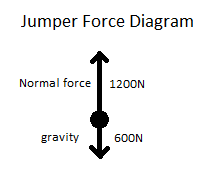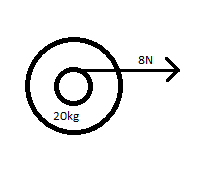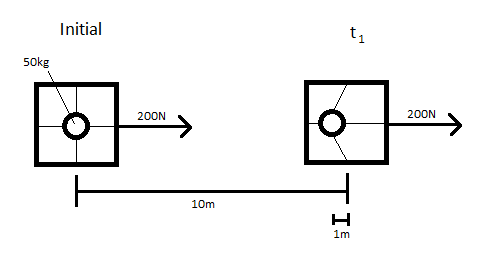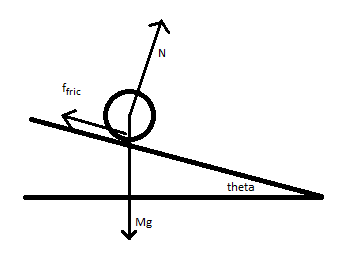Point Particle Systems
This page describes point particle systems and how they can be used to model certain aspects of a system's motion.
The Main Idea
A point particle system is a physical system, usually composed of multiple parts, modeled as though it were a single particle at its Center of Mass.
When work is done on a system, the energy imparted on it may take on multiple forms. These include Translational, Rotational and Vibrational Energy, Potential Energy, and Thermal Energy. Translational kinetic energy is kinetic energy due to the movement of the system's center of mass. All other types of energy the system has are considered "internal" types of energy because they do not affect the system's motion through its environment, but rather indicate its local properties. Sometimes, when work is done on a system, it imparts both translational kinetic energy and internal types of energy. For example, consider a ball rolling down a ramp. Gravity does work on the ball and increases its energy. It gains some translational kinetic energy (its center of mass gains a velocity down the ramp) and some rotational kinetic energy (its rolling motion causes it to rotate about its center of mass).
Forces acting on a real system can affect both the system's translational acceleration and, depending what part of the system they act on, the internal state of the system. The purpose of modeling a system as a point particle system is to easier to calculate how forces acting on it affect its translational motion through its environment. By modeling the system as a point particle, all forces are assumed to act directly on the system’s center of mass, allowing us to examine only the translational effects of the forces. The net force acting on the point particle causes it to accelerate according to Newton's Second Law: the Momentum Principle.
From an energy perspective, a real system might have multiple types of work done on it at once; it might experience an increase in translational kinetic energy as well as an increase in some types of internal energy. By modeling the system as a point particle, we find only some of the work that is actually done on the system because we look at the displacement of the system's center of mass rather than the part of the system on which the force acts. Specifically, we find the work that affects only its translational kinetic energy because translational kinetic energy is the only energy a system can have when it is reduced to a point particle.
Modeling a system as a point particle offers no insights about the internal state of the system because only forces and work affecting its translational motion can be found.
Point particle systems are in contrast to Real Systems (also known as extended systems), which analyze each part of a system individually instead of reducing it to a single point. Real systems can model a system's internal behavior in addition to its motion through its environment, although they can be very complicated and difficult to analyze quantitatively. Often, to obtain a complete model of a system's behavior, both point-particle and extended models are used.
You may not be aware of it, but you have been modeling systems as point particles for most problems through week 9 because you have mostly been analyzing the translational motion of rigid bodies without regard for their internal energies. Now that we are starting to look at internal types of energy, it becomes more important to separate point particle systems and real systems, and to understand what each model is able to accurately represent.
A Mathematical Model
The mathematical concepts used to analyze point particle systems depend on the system. Often, the work-energy theorem is used. This section explains how to use the work-energy theorem for a point particle system because this is the concept that varies the most significantly from its application to real systems.
The work done on a point particle system is defined as
[math]\displaystyle{ W = \int \vec{F_{net}} \cdot d \vec{r} }[/math],
where [math]\displaystyle{ \vec{r} }[/math] is the position of the particle.
Let us assume that the net force acting on the particle is constant, so that we can get rid of the integral, and that the net force acts in the direction of the particle's motion, so that we can replace the dot product with regular multiplication. This will be the case for most point particle system problems involving work. With these assumptions, the work done on a point particle is given by
[math]\displaystyle{ W = F_{net} * d }[/math]
where [math]\displaystyle{ F_{net} }[/math] is the magnitude of the net force acting on the particle and [math]\displaystyle{ d }[/math] is the distance over which the force is exerted. For point particle systems, that is the distance traveled by the particle. This contrasts with real systems, where the distance over which the force is exerted depends on the movement of particular parts within the system.
The work-energy theorem states that work done on a system increases that system's energy. A point particle cannot experience an increase in internal energy. For example, the moment of inertia of a point particle about its center of mass is 0, so it can have no rotational kinetic energy. This means that all of the work done on a point particle system becomes translational kinetic energy.
In other words, for a point particle system,
[math]\displaystyle{ \Delta KE = F_{net} * d }[/math]
and
[math]\displaystyle{ KE = \frac{1}{2} m v^2 }[/math].
The two equations above are the basis for answering work/energy questions using point particle systems. It is important to remember that when modeling a system as a point particle system, calculating the work done on the system as described above does not find all of the work done on the system, but rather just the work that becomes translational kinetic energy.
Examples
1. (Simple)
A 60kg person jumps straight up in the air from a crouching position. From the time the person begins to push off of the ground to the time their feet leave the ground, their center of mass moves up 2m, and the normal force between the ground and the person's feet has a constant magnitude of twice the person's weight. Find the velocity of the jumper at the moment their feet leave the ground. Use 10m/s2 for g.
Solution:
Let us model the person as a point particle system. A force diagram for the person would look like this:
The net force acting on the person is the vector sum of the upward normal force and the downward gravitational force, which is a 600N force upwards. This force is constant and in the same direction as the person's motion, so multiplying it by the 2m displacement of the center of mass yields the work done on the person by their muscles:
[math]\displaystyle{ W = 600 * 2 = 1200 }[/math]Nm.
The person begins at rest, so their initial kinetic energy is 0J and their final energy is 1200J.
[math]\displaystyle{ \frac{1}{2} m v^2 = KE }[/math]
[math]\displaystyle{ \frac{1}{2} * 60 * v^2 = 1200 }[/math]
[math]\displaystyle{ v = \sqrt{40} }[/math]m/s.
2. (Middling)
A giant 20kg yo-yo floats at rest in space. Its string (whose mass is negligible compared to the mass of the yo-yo) is pulled with a constant force of 8N. What is the speed of the yo-yo when it has travelled 5m?
Solution:
Solving this problem using energy while treating the system as a real system would be difficult; it would require knowledge of rotational physics and would require more steps. Let us therefore analyze it as a point particle system. This allows us to find only the work done on the yo-yo that is converted to translational kinetic energy.
Treating the yo-yo as a point particle, the work done on it is given by the magnitude of the net force times the particle's displacement:
[math]\displaystyle{ W = 8 * 5 = 40 }[/math]Nm
The point particle's kinetic energy was originally 0, so it is now 40J.
[math]\displaystyle{ KE = \frac{1}{2} m v^2 }[/math]
[math]\displaystyle{ 40 = \frac{1}{2} * 20 * v^2 }[/math]
[math]\displaystyle{ v = 2 }[/math]m/s.
The point particle represents the center of mass of the yo-yo, so it must be moving at 2m/s.
3. (Middling)
A 50kg metal sphere is suspended in the inside of a large cubic box of negligible mass by six rubber bands- one attaching the sphere to each face of the box. The box and the sphere are initially at rest. A 200N rightward force is applied to the side of the box, causing it to accelerate. At time [math]\displaystyle{ t_1 }[/math], the box has been displaced by 10m to the right. At this time, the sphere is no longer exactly in the center of the box; it is 1m to the left of the center of the box due to its inertia. What is the speed of the sphere at time [math]\displaystyle{ t_1 }[/math]?
Solution:
Let us model the sphere-box system as a point particle system. The center of mass of the system is simply the center of the sphere because the box has negligible mass. The work done on the particle is given by the force acting on the particle times its displacement:
[math]\displaystyle{ W = 200 * 9 = 1800 }[/math]Nm. The displacement of the particle is only 9m because although the box was displaced 10m, the sphere was only displaced 9m due to its inertia and the non-rigidity of its suspension within the box.
The particle initially had no energy, so its energy at time [math]\displaystyle{ t_1 }[/math] is 1800J.
[math]\displaystyle{ KE = \frac{1}{2} m v^2 }[/math]
[math]\displaystyle{ 1800 = \frac{1}{2} * 50 * v^2 }[/math]
[math]\displaystyle{ v = \sqrt{72} }[/math]m/s.
4. (Middling)
A uniform disk of mass [math]\displaystyle{ M }[/math] starts at rest and rolls without slipping down a ramp. The plane of the ramp makes an angle of [math]\displaystyle{ \Theta }[/math] with the horizontal. The force of Static Friction acting on the bottom of such a disk, causing it to rotate, always has a magnitude of 1/3 the force acting to move the disk down the ramp. What is the translational speed of the disk after it has traveled a distance of [math]\displaystyle{ d }[/math] diagonally down the ramp?
Solution:
Let us analyze this system as a point particle system because we are only interested in its translational motion.
The component of the disk's weight perpendicular to the ramp is balanced by the normal force, so only the force acting to accelerate the disk down the ramp is the component of the disk's weight parallel to the ramp. This can be found to be
[math]\displaystyle{ f_{grav, x} = Mg \sin \Theta }[/math]
using trigonometry. The friction force therefore has a magnitude of
[math]\displaystyle{ f_{fric, x} = \frac{1}{3} Mg \sin \Theta }[/math]
and opposes the direction the disk's motion, pointing up the ramp.
Since we are modeling the disk as a point particle system, we simply treat both of these forces as though they act on the disk's center of mass. The net force acting on the particle is therefore
[math]\displaystyle{ f_{net} = \frac{2}{3} Mg \sin \Theta }[/math] down the ramp.
To find the work done on the particle, we simply multiply the net force by the displacement of the particle:
[math]\displaystyle{ W = \frac{2}{3} Mg \sin \Theta * d }[/math]
Since the disk had no initial kinetic translational energy, its final translational kinetic energy is equal to the work done on it.
[math]\displaystyle{ \frac{1}{2} M v^2 = \frac{2}{3} Mg \sin \Theta * d }[/math]
[math]\displaystyle{ v = \sqrt{ \frac{4}{3} g \sin \Theta * d } }[/math].
5. (Difficult)
A pair of 10kg masses are connected by a massless spring of unknown spring constant. They begin at rest at the spring's equilibrium length. A 30N rightward force is applied to the mass on the right for 4s. At the end of the 4 second period, the force ceases to act and the mass on the right has traveled 20m. The system continues to travel to the right, and the distance between the two masses oscillates sinusoidally. How much vibrational kinetic energy does the system have? (Vibrational kinetic energy is the energy of the mass' oscillatory movement, as opposed to their translational kinetic energy, which is the energy of the rightward movement of their center of mass.)
Here is a simulation of the system to help you visualize it.
Note: this problem requires the system to be modeled both as a real system and as a point particle system.
Solution:
Let us first analyze this system as a real system. The work done by the rightward force on the real system is given by its magnitude times the distance traveled by its point of contact, or the rightmost block:
[math]\displaystyle{ W = 30 * 20 = 600 }[/math]Nm.
Now, let us treat the system as a point particle system to find the particle's kinetic energy (the real system's translational kinetic energy). We are now modeling the system of two masses as a single point at its center of mass. That is, we are now treating the system as a single mass of 20kg. A 30N force is applied to the particle for 4 seconds, so its acceleration is given by
[math]\displaystyle{ \vec{a} = \frac{\vec{f}}{m} = \frac{3}{2} }[/math]m/s.
and its displacement at the end of the 4 second period is given by
[math]\displaystyle{ d = \frac{1}{2} a t^2 = \frac{1}{2} * \frac{3}{2} * 4^2 = 12 }[/math]m.
The work done by the rightward force on the point particle system is given by its magnitude times the displacement of that particle:
[math]\displaystyle{ W = 30 * 12 = 360 }[/math]Nm.
Recall that the work done on the point particle system represents the increase in translational kinetic energy of the real system, so the system now has 360J of translational kinetic energy.
It was found earlier that the force imparted a total of 600J of energy to the real system, so [math]\displaystyle{ 600-360=240 }[/math] of the system's joules are oscillatory energy.
Connectedness
Scenario: Acrobatics
Consider an acrobat who has jumped from a trampoline and is now on a trajectory through the air. The acrobat is performing a flip and is therefore turning, and they can tuck in or extend their arms in order to affect their moment of inertia and thereby their rotational rate and rotational kinetic energy. Modeling the trajectory of the acrobat may seem complicated, but it can be easily found by modeling the acrobat as a point particle system. When the acrobat is reduced to a point particle, the only force acting on them (ignoring air resistance) is gravity. This means gravity is the only force that can affect the acrobat's translational motion and therefore trajectory, so the acrobat obeys regular Projectile Motion. Any forces that are present in the real system but not in the point particle system, such as the acrobat's muscles, can only affect the internal energies of the acrobat system, so any movement the acrobat does in the air does not affect their trajectory. This is something acrobats know well; to land in a certain place, they must correctly push off when jumping, and then they are free to do whatever tricks they want while in the air.
See also
External links
A helpful page for additional info: http://p3server.pa.msu.edu/coursewiki/doku.php?id=183_notes:pp_vs_real
A helpful video lecture: https://www.youtube.com/watch?v=T780lL5FlLg&index=41&list=PL9HgJKLOnKxedh-yIp7FDzUTwZeTeoR-Y
An example of another practice problem: https://www.youtube.com/watch?v=FyJTgG3a2hY
References
Chabay, Ruth W., and Bruce A. Sherwood. "9." Matter & Interactions. N.p.: n.p., n.d. N. pag. Print.
Purdue Physics. https://www.physics.purdue.edu/webapps/index.php/course_document/index/phys172/1160/42/5399.




